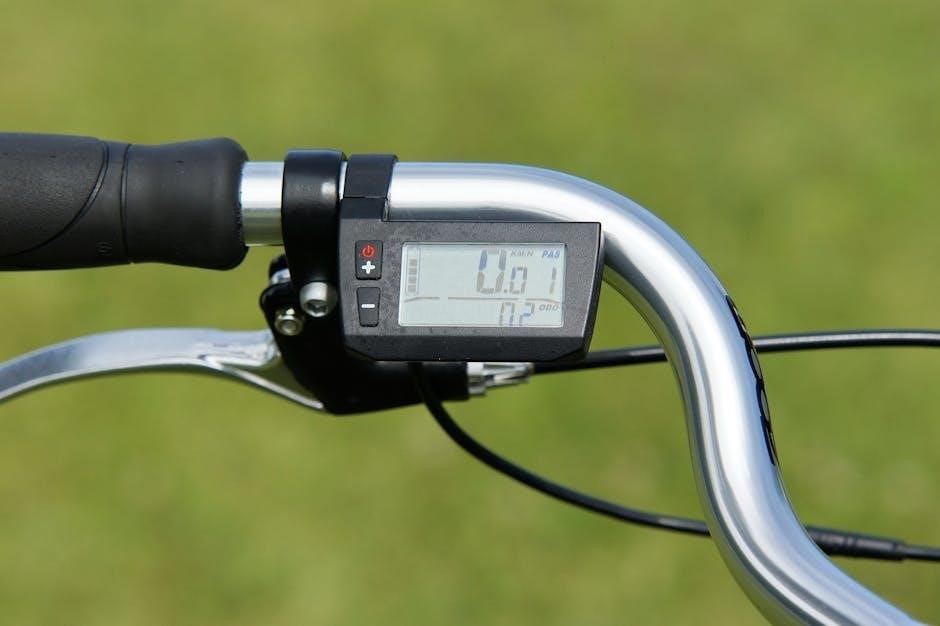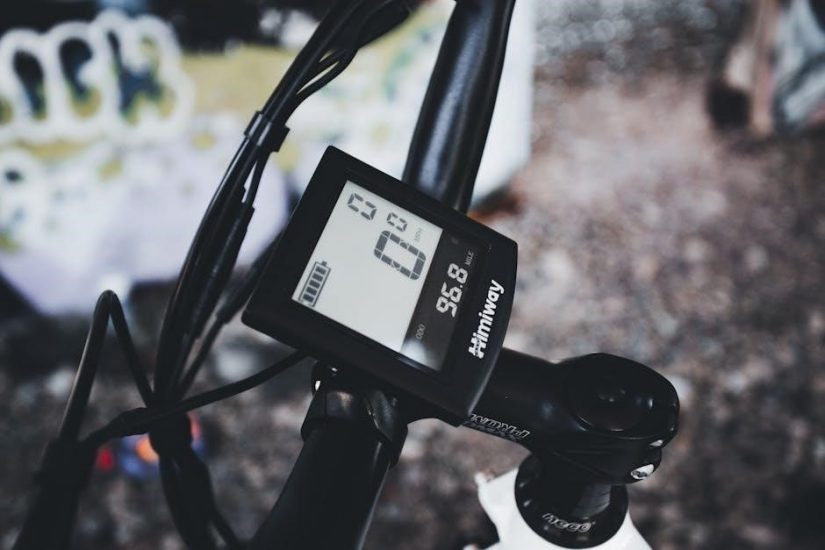Accurate bicycle measurements are crucial for optimal performance, comfort, and safety. This guide provides a comprehensive overview of key metrics, ensuring proper fit and functionality for riders of all levels.
1.1 Importance of Proper Bicycle Measurements
Proper bicycle measurements are crucial for ensuring a comfortable, efficient, and safe riding experience. Accurate sizing prevents discomfort, enhances performance, and reduces the risk of injury. Whether for casual rides or competitive cycling, correct measurements ensure optimal fit, improving control and overall enjoyment. This guide helps riders understand the significance of precise measurements in achieving the best riding experience possible.
1.2 Overview of Key Measurement Points
Key bicycle measurements include frame size, seat height, handlebar width, wheel size, and standover height. These metrics ensure proper fit, comfort, and performance. Accurate measurements also cover crank length, chainstay, and tire clearance, which are vital for functionality and safety. Understanding these points helps riders optimize their bike setup for efficiency and enjoyment, whether on-road or off-road.

Understanding Frame Size
Understanding frame size is essential for a comfortable and efficient ride. It’s typically measured from the bottom bracket to the seat tube top, ensuring proper standover clearance and fit for various bike types, like road or mountain bikes. Accurate sizing enhances performance and reduces discomfort.
2.1 How to Measure Your Bike Frame
To measure your bike frame accurately, start by locating the bottom bracket, the metal part where the pedals attach. Use a flexible measuring tape to measure from the center of the bottom bracket straight up to the top of the seat tube. Ensure the tape is aligned properly to avoid angled measurements. This will give you the frame size, which varies by bike type and manufacturer. Always refer to the manufacturer’s size chart for accurate sizing and consider checking standover height for safety and comfort. Using precise tools like a digital caliper can enhance accuracy, but a flexible tape suffices for most needs. Double-checking measurements ensures proper fit and optimal performance.
2.2 Frame Size Charts for Different Bike Types
Frame size charts vary by bike type, with road, mountain, and hybrid bikes having distinct measurements. Manufacturers provide charts to match rider height and inseam to frame size. Road bikes often use precise sizing for aerodynamics, while mountain bikes focus on standover clearance for safety. Always consult the manufacturer’s chart for your specific bike type, as sizes can differ between brands and models. Proper frame size ensures optimal performance, comfort, and safety.

Seat Height and Saddle Position
Proper seat height ensures efficient pedaling and comfort, while saddle position affects weight distribution and posture. Adjustments should prioritize rider comfort and optimal performance.
3.1 Measuring and Adjusting Seat Height
To measure seat height, stand beside the bike with the pedal at the bottom of its stroke. The height should allow a 25-30 degree knee bend. Adjust the seatpost smoothly, ensuring the saddle is level. Proper alignment prevents discomfort and enhances pedaling efficiency, making long rides more enjoyable and reducing the risk of injury or strain.
3.2 Proper Saddle Fore-Aft Positioning
Proper saddle fore-aft positioning ensures optimal balance and pedaling efficiency. The saddle should be level, with the rider’s knee aligned over the pedal spindle when the pedal is at 3 o’clock. Adjust the saddle position by sliding it along the seatpost, ensuring it supports your sitting bones comfortably. Correct positioning enhances comfort and efficiency, reducing strain during rides.

Handlebar Measurements
Handlebar measurements are crucial for comfort and control, with width matching shoulder width and height adjustable for posture. Proper fit enhances riding efficiency and reduces strain.
4.1 Handlebar Width and Reach
Handlebar width and reach are critical for ergonomics and control. The width should match your shoulder width for optimal aerodynamics and comfort. Reach refers to the horizontal distance from the stem to the bar’s end. Proper reach ensures a neutral back and wrist position, reducing strain. Different handlebars, such as drop bars or flat bars, vary in width and reach to suit riding styles and preferences.
4.2 Adjusting Handlebar Height and Angle
Adjusting handlebar height and angle ensures proper ergonomics and comfort. Start with a neutral position, then fine-tune based on riding style. Use Allen keys to loosen bolts, adjust the height for a slight elbow bend, and tilt the bars for wrist comfort. Proper alignment reduces strain and enhances control. Experiment with small changes to find your ideal setup.

Wheel Size and Tire Clearance
Wheel size and tire clearance are critical for performance, affecting speed, comfort, and efficiency. Proper clearance ensures smooth operation and prevents frame or component damage. Always verify compatibility with accessories.
5.1 Common Wheel Sizes and Their Uses
Common bicycle wheel sizes include 26″, 27.5″, 29″, and 700c, each suited for specific terrains and bike types. Mountain bikes often use 27.5″ or 29″ wheels for stability, while road bikes favor 700c for speed. Smaller wheels, like 26″, are ideal for BMX or folding bikes, offering maneuverability. Understanding wheel size ensures optimal performance and compatibility with frames and tires, enhancing ride quality and efficiency. Proper tire clearance is essential for safety and functionality, preventing frame or component damage. Always verify compatibility with accessories and terrain requirements, ensuring a smooth and efficient ride.
5.2 Measuring Tire Clearance for Accessories
Measuring tire clearance ensures compatibility with accessories like fenders, racks, and wider tires. Use a ruler to check space between the tire and frame or fork. Adequate clearance prevents rubbing and damage. For fenders, measure at the tightest points—usually near the fork crown and seatstays. Ensure at least 5mm clearance on both sides for standard fenders, and more for larger tires or mudguards. Proper clearance enhances safety and functionality, avoiding potential frame or component damage. Always verify measurements before installing new accessories to maintain optimal performance and rider comfort. Regular checks ensure long-term reliability and prevent unexpected issues during rides. Accuracy is key to enjoying a trouble-free cycling experience.

Standover Height and Safety
Standover height ensures safe dismounting and minimized injury risk. Correct measurement involves standing over the frame with feet flat, maintaining 1-2 inches of clearance for road bikes and 2-4 inches for mountain bikes. Proper clearance allows easy maneuverability and reduces accident chances, ensuring a safer riding experience for cyclists of all skill levels. Accurate measurement is vital for optimal safety and confidence on the road or trail. Regular checks help maintain safety standards and prevent potential hazards. Always prioritize standover height for a secure and enjoyable ride.
6.1 How to Measure Standover Height
To measure standover height, stand over the bicycle with feet flat on the ground, knees slightly bent. Measure the gap between the crotch and the top tube. For road bikes, 1-2 inches is ideal, while mountain bikes require 2-4 inches. Ensure the bike is on a level surface and wear riding shoes for accurate results. This ensures safety and comfort, preventing injuries and improving control while riding. Proper measurement is essential for a safe and enjoyable cycling experience.
6.2 Safety Guidelines for Standover Clearance
Standover clearance ensures safe dismounts and reduces crash risks. Maintain at least 1-2 inches for road bikes and 2-4 inches for mountain bikes. Proper clearance prevents injuries and improves control. Always wear appropriate footwear and test clearance before riding. Adjusting the bike to fit your body ensures a safer, more enjoyable cycling experience. Proper fit is key to safety and performance.

Gearing and Chainstay Measurements
Gearing and chainstay measurements optimize performance and efficiency. Proper chainstay length ensures stability, while accurate gear ratios enhance pedaling ease and compatibility with terrain and rider preference.
7.1 Measuring Chainstay Length
Chainstay length is critical for bike handling and tire clearance. To measure, locate the rear axle and the bottom bracket shell. Use a ruler or caliper to record the distance between these two points. Ensure accuracy by measuring from the center of the axle to the center of the shell. This measurement impacts bike geometry and performance, so precision is key for optimal setup and ride quality.
7.2 Understanding Gear Ratios and Compatibility
Gear ratios significantly impact a bicycle’s performance, determining pedaling difficulty and speed. They are calculated by dividing the chainring’s tooth count by the cog’s. Higher ratios suit flat terrains, while lower ratios aid climbing. Ensuring compatibility between cranksets, cassettes, and derailleurs is crucial for smooth shifting. Always check specifications when upgrading components to maintain optimal functionality and avoid mechanical issues.

Crank Length and Pedal Alignment
Crank length impacts pedaling efficiency and comfort, while proper pedal alignment ensures smooth power transfer. Both measurements are crucial for optimizing performance and reducing the risk of mechanical issues.
8.1 How to Measure Crank Length
Measuring crank length involves determining the distance from the pedal spindle to the center of the crank arm. Use a ruler or caliper to ensure accuracy. This measurement is essential for selecting the correct crank length, which affects pedaling efficiency and rider comfort. Proper measurement ensures optimal performance and reduces the risk of mechanical issues or discomfort during rides.
8.2 Importance of Pedal Alignment
Proper pedal alignment ensures efficient power transfer and reduces the risk of knee strain or injury. Misaligned pedals can cause uneven wear on components and affect riding performance. Aligning pedals symmetrically guarantees balanced force distribution, enhancing overall cycling efficiency and comfort. Correct alignment is critical for both competitive cyclists and casual riders to maintain optimal biomechanics and prevent long-term discomfort or damage to the bike.
Measuring for Accessories and Upgrades
Measuring for Accessories and Upgrades is crucial for ensuring compatibility and functionality. Precise measurements guarantee proper fitment of racks, fenders, and other essential components.
9.1 Measuring for Racks and Fenders
Measuring for racks and fenders ensures proper fitment and functionality. Measure the frame’s mounting points, tire clearance, and available space for accessories. Ensure the rack fits the frame size and weight capacity, while fenders must align with wheel size and fork clearance for optimal performance.
Use a tape measure or calipers for precise dimensions. Consider the bike’s intended use to choose compatible accessories, ensuring both practicality and style.
9.2 Determining Compatibility for Parts Upgrades
Determining compatibility for parts upgrades involves checking dimensions, material standards, and brand-specific requirements. Measure crank length, chainstay clearance, and brake rotor size to ensure new components fit seamlessly. Consult manufacturer guidelines for gear compatibility and wheel standards to avoid mismatches. Proper alignment and fitment are crucial for performance and safety, so double-check specifications before installation.

Final Tips for Accurate Measurements
For precise measurements, use calibrated tools and ensure the bike is on a level surface. Double-check calculations and refer to manufacturer guidelines for specific components.
10.1 Tools Needed for Precise Measurements
Essential tools include a sturdy tape measure, digital calipers for precise frame and component measurements, and a torque wrench for secure bolt adjustments. A level ensures accurate positioning, while Allen keys and wrenches help with adjustments. Use a clean, flat workspace and consult manufacturer guidelines for specific measurements to ensure accuracy and safety.
10.2 Common Mistakes to Avoid
Common errors include improper frame sizing, misaligned saddles, and incorrect handlebar adjustments. Neglecting standover clearance and inaccurate tire measurements can lead to safety issues. Using the wrong tools or mismeasuring components like crank length or chainstay can affect performance. Always double-check measurements and refer to manufacturer guidelines to ensure accuracy and optimal bike setup for a safe and enjoyable riding experience.
